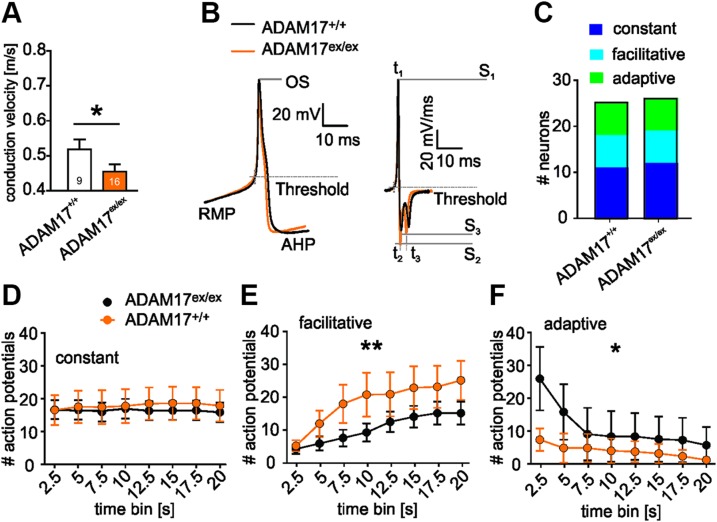Figure 6.
Down-regulated ADAM17 affects neuron biophysical properties. A) The average conduction velocity of cold-sensitive C-fibers in ADAM17ex/ex skin-nerve recordings was reduced compared with that of ADAM17+/+ cold-responsive C-fibers (ADAM17+/+ n = 12 and ADAM17ex/ex n = 20, P = 0.047, Student’s t test). B) Representative AP recording from an ADAM17+/+ and ADAM17ex/ex DRG nociceptive neuron and its first derivative used for AP characterization; the shape and AP kinetics were comparable between the 2 genotypes. AP parameters, e.g., RMP, AHP, threshold, AP speed of depolarization (S1) and repolarization (S2, S3), and the corresponding time points (t1, t2, t3) were analyzed OS, overshoot. C) Distribution of ADAM17+/+ and ADAM17ex/ex sensory neurons with constant, adaptive, or facilitative firing patterns did not differ between both genotypes (χ2 test, P = 0.9981). D) Number of generated APs (averaged over 2.5 s time bins) of the constant firing ADAM17ex/ex sensory neurons was unaltered (2-way ANOVA, genotype factor P = 0.8061, ADAM17+/+ n = 11 and ADAM17ex/ex n = 12). E, F) Whereas ADAM17ex/ex sensory neurons showed an increased facilitative firing frequency in comparison with ADAM17+/+ sensory neurons (E; 2-way ANOVA, genotype factor P < 0.01, ADAM17+/+ n = 7 and ADAM17ex/ex n = 7), the adaptive firing frequency of ADAM17ex/ex sensory neurons (F) was significantly lower than that of their ADAM17+/+ counterparts (2-way ANOVA, genotype factor P < 0.05, ADAM17+/+ n = 7 and ADAM17ex/ex n = 7). Results are shown as means ± sem. *P < 0.05, **P < 0.01.

